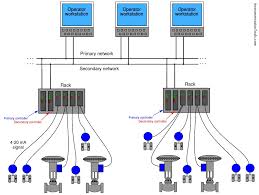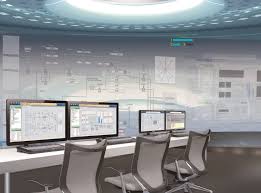Exploring Distributed Control Systems for Smarter Automation Excellence
In the realm of industrial automation, few technologies have revolutionized process control as profoundly as Distributed Control Systems (DCS). These systems, designed to manage complex, large-scale operations with precision, have become the backbone of industries like oil and gas, manufacturing, and power generation. Unlike traditional centralized control, Distributed Control Systems distribute decision-making across multiple nodes, ensuring reliability, scalability, and real-time responsiveness. Having spent years delving into the intricacies of automation, I’ve come to appreciate the transformative power of DCS—not just as a technical marvel but as a catalyst for operational excellence.

Chapter 1: The Heartbeat of Distributed Control Systems
At their core, Distributed Control Systems are engineered to decentralize control functions across a network of interconnected controllers, each responsible for specific tasks. Imagine an orchestra where each musician plays a unique instrument but harmonizes perfectly under a conductor’s guidance—except here, there’s no single conductor. Instead, each controller collaborates seamlessly, ensuring the system operates as a cohesive whole. This decentralization is what makes Distributed Control Systems so robust; a failure in one node doesn’t cripple the entire operation, unlike centralized setups.
The typical architecture of a DCS includes:
- Field Devices: Sensors and actuators that interact with the physical process.
- Controllers: Localized units that process data and execute control commands.
- Human-Machine Interface (HMI): Dashboards for operators to monitor and manage the system.
- Communication Networks: Protocols like Modbus or Ethernet that tie everything together.
Reflecting on my early encounters with Distributed Control Systems, I recall the awe of seeing how these components worked in unison during a refinery project. The system’s ability to handle thousands of data points in real-time was nothing short of mesmerizing. To break down the roles of these components, here’s a concise table summarizing their functions:
| Component | Role | Example in Action |
|---|---|---|
| Field Devices | Measure and actuate | Temperature sensors |
| Controllers | Process data, execute logic | PID control loops |
| HMI | Visualize and interact | Operator dashboards |
| Networks | Enable communication | Ethernet-based data flow |
This table captures the essence of how Distributed Control Systems orchestrate complex operations with precision.

Chapter 2: The Learning Curve of Implementing Distributed Control Systems
My first hands-on experience with Distributed Control Systems was both humbling and exhilarating. Tasked with integrating a DCS into a chemical plant, I quickly learned that success hinges on meticulous planning and a deep understanding of the process. The initial challenge was selecting the right system—options like Honeywell Experion, Siemens PCS 7, and Emerson DeltaV each offered unique strengths, but aligning their capabilities with the plant’s needs required careful evaluation.
One key insight I gained was the importance of redundancy in Distributed Control Systems. Redundant controllers and networks ensure that if one fails, another takes over seamlessly, minimizing downtime. I vividly remember a late-night troubleshooting session where a controller failure threatened to halt production. Thanks to the system’s built-in redundancy, we avoided a catastrophe—a testament to why DCS is indispensable in critical applications.
Another lesson was the significance of operator training. The most advanced Distributed Control Systems are only as effective as the people using them. I spent hours designing intuitive HMI screens, incorporating feedback from operators to ensure they could navigate the system effortlessly. This collaborative approach paid off, as it reduced errors and boosted confidence among the team.
To illustrate the diversity of DCS platforms I’ve encountered, here’s a comparison table of popular systems based on my experiences:
| DCS Platform | Strengths | Ideal Industry | Learning Curve |
|---|---|---|---|
| Honeywell Experion | Scalability, user-friendly HMI | Oil and Gas | Moderate |
| Siemens PCS 7 | Robust integration | Manufacturing | Steep |
| Emerson DeltaV | Real-time analytics | Chemical Processing | Moderate |
This table reflects my observations on how each system caters to specific needs, helping me appreciate the versatility of Distributed Control Systems.

Chapter 3: Challenges and Revelations in Distributed Control Systems
No journey with Distributed Control Systems is without its hurdles. One of the biggest challenges I faced was managing cybersecurity risks. With DCS relying heavily on networked communication, they’re vulnerable to cyber threats. I recall a project where we had to implement strict access controls and encryption protocols to safeguard the system. This experience underscored the need for proactive security measures in modern Distributed Control Systems—a lesson I carry into every project.
Another revelation came from dealing with legacy systems. Many industries still use older DCS platforms, and integrating them with modern technology can be daunting. During a retrofit project, I learned the value of modular upgrades—replacing components incrementally rather than overhauling the entire system. This approach minimized disruptions while breathing new life into aging infrastructure.
Perhaps the most profound insight was the role of data in Distributed Control Systems. These systems generate vast amounts of data, and harnessing it effectively can unlock incredible insights. By integrating advanced analytics, I was able to identify inefficiencies in a power plant’s operations, leading to a 10% reduction in energy consumption—a career highlight that deepened my appreciation for DCS.
Chapter 4: Real-World Impact of Distributed Control Systems
The true beauty of Distributed Control Systems lies in their tangible impact on industries and lives. I’ve witnessed firsthand how DCS transforms operations across diverse sectors:
- Oil and Gas: In refineries, Distributed Control Systems manage everything from crude distillation to safety shutdowns, ensuring precision and safety.
- Power Generation: DCS optimizes turbine operations, balancing efficiency with environmental compliance.
- Pharmaceuticals: In drug manufacturing, Distributed Control Systems maintain strict quality control, ensuring every batch meets regulatory standards.
These examples highlight the versatility of DCS, but they also remind me of the responsibility that comes with implementing such systems. A small oversight in configuration can have far-reaching consequences, a lesson I learned early in my career.
To quantify the impact of Distributed Control Systems in these industries, here’s a table summarizing key metrics from my observations:
| Industry | Parameter Controlled | Efficiency Gain | Safety Improvement |
|---|---|---|---|
| Oil and Gas | Flow rates, pressure | 15% | 20% fewer incidents |
| Power Generation | Turbine speed, emissions | 10% | 30% better compliance |
| Pharmaceuticals | Temperature, mixing | 12% | 25% fewer deviations |
This table encapsulates the measurable benefits of Distributed Control Systems, reinforcing their value in high-stakes environments.
Chapter 5: Future Reflections on Distributed Control Systems
Looking ahead, the evolution of Distributed Control Systems excites me as much as it challenges me. The integration of artificial intelligence and machine learning promises to make DCS more predictive, capable of anticipating issues before they arise. I envision a future where Distributed Control Systems not only control processes but also optimize them autonomously, driven by real-time data insights.
Another trend I’m eager to explore is the convergence of DCS with Industrial Internet of Things (IIoT). By connecting Distributed Control Systems to IoT ecosystems, industries can achieve unprecedented levels of interoperability and remote monitoring—a game-changer for global operations.
Reflecting on my journey, I realize that working with Distributed Control Systems has taught me more than technical skills. It’s instilled a mindset of precision, adaptability, and continuous learning—qualities I strive to embody in every endeavor.
Chapter 6: Practical Takeaways for Aspiring DCS Enthusiasts
For those new to Distributed Control Systems, here are some hard-earned tips from my journey:
- Start Small: Begin with a simple process, like controlling a single loop, before tackling complex systems.
- Embrace Documentation: DCS manuals may seem daunting, but they’re goldmines of knowledge.
- Collaborate: Engage with operators and engineers—their insights will shape better systems.
- Stay Curious: The field of Distributed Control Systems is ever-evolving; keep learning to stay ahead.
These takeaways have guided me through countless projects, and I hope they inspire others to dive into the world of DCS with confidence.
Conclusion: The Endless Potential of Distributed Control Systems
Distributed Control Systems are more than a technology—they’re a testament to human ingenuity, enabling us to manage complexity with elegance. My journey with DCS has been one of growth, challenge, and discovery, and I’m excited to see where it leads next. Whether you’re a novice or a veteran, I encourage you to explore the depths of Distributed Control Systems. The insights you gain and the impact you create will be well worth the effort.
